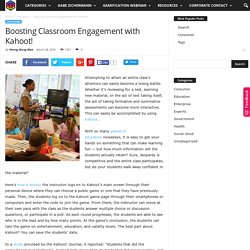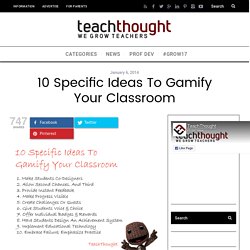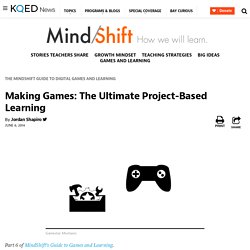

Games in Schools - My learning diary. Boosting Classroom Engagement with Kahoot! Attempting to attain an entire class’s attention can easily become a losing battle.

Whether it’s reviewing for a test, learning new material, or the act of test taking itself, the act of taking formative and summative assessments can become more interactive. This can easily be accomplished by using Kahoot. With so many games in education nowadays, it is easy to get your hands on something that can make learning fun — but how much information will the students actually retain? Sure, Jeopardy is competitive and the entire class participates, but do your students walk away confident in the material? Here’s how it works: the instructor logs on to Kahoot’s main screen through their personal device where they can choose a public game or one that they have previously made. In a study provided by the Kahoot! 10 Specific Ideas To Gamify Your Classroom by Mike Acedo In today’s classroom, educators are constantly required to mold their teaching methods to give students the best opportunity to succeed.

It is not only imperative for students to learn the required material, but also critical that students gain a sense of confidence toward their work, and find motivation to expand their learning. However, this can be difficult for some students, who may struggle in traditional, lecture-based class styles. For some students, finding the motivation to complete homework or prepare for class can be a constant struggle, especially when every effort is met with a poor grade or frustration from teachers and parents. We’ve talked about designing your classroom like a video game before. How To Gamify Your Classroom: 10 Specific Ideas To Get It Done 1. Present the class syllabus as a form of Gamification. 2. Like in video games, students should be allowed second chances. 3. ESL games in adult classes - Articles. Construct 2 - Create Your Own Games. Construct 2 lets you make games visually, no programming required!

You and Construct 2 — The perfect way to become a game developer today! Buy Now Pricing No monthly fees, you pay once and have access to Construct 2 for life. If the Construct 2 editor is updated, you'll get the update for free! The Gamification of Education Infographic #gamification #edtech. The Gamification of Education Infographic #gamification #edtech. Defining competencies via Gamification. Build out Learning Competencies through a Gamification Strategy – something simple and something that works!

Competency development is one of the most foundational and tricky areas of learning. Building out good competencies- which map to good learning, that map to good assessment- allows for a full feedback model that you can use to track learner development and understand and address knowledge gaps. The challenge with delivering training on a competency model after it is built out is that often times it is presented in a way that is much too formal for the average learner to get much use out of. Many times you have built excellent terminal and enabling objectives, fantastic performance objectives and have spent a good deal of time mapping everything to a learning plan with assessments and gap assessment models built in.
When it is presented to your learners they fail to see the blood, sweat and tears that went into this plan and many times just don’t see the beauty of your hard work. Outcomes of game-based learning: Research roundup - Journalist's Resource Journalist's Resource. (iStock) Constructivism, or learning by doing, is a classic approach to educational instruction that has generated renewed interest in the digital era.

Making Games: The Ultimate Project-Based Learning. Part 6 of MindShift’s Guide to Games and Learning.

As game-based learning increases in popularity, it’s easy to get pigeon-holed into one particular way of thinking about it or one way of employing it. This is true regardless of how teachers feel about gaming in the classroom, whether they’re for or against it. One common objection to game-based learning is that students will sit in front of screens being taught at. Sure, games are interactive, but on some level, don’t they still just replace the sage on the stage with the sage on the screen? Writer - Education. Education inkle is looking to bring interactive stories to the classroom, and give teachers free and simple get-stuck-right-in software to use with their students.

From within a web-browser, the inklewriter will let students make and play interactive stories with no programming required. Why make stories interactive anyway? The way our stories work is simple: the reader is given the text of a story in a small chunks, and after each, they get to make a decision about what happens next. That could be what a character says, or does - but it could also be a deeper choice, like why a character has done what they've done, or how they feel about something else in the story. Our first project, Frankenstein, uses interactivity to explore the different facets of Mary Shelley's original novel - allowing the reader to discover different aspects of the world, follow up hints and allusions in the text, and maybe even take some narrative paths that Shelley herself considered.
Core Concepts of Gamification. Outstanding presentation from Amy Jo Kim, an adjunct professor of Game Design at USC’s Digital Media school, recently named top US-based game design school.

She’s also the author of Community Building on the Web (2000), a design handbook for digital communities that’s used worldwide at game studios & universities. [Email Amy]. This presentation was delivered at Casual Connect Seattle, July 2011. A few of the highlights of the presentation and how they compare to sales and marketing: “What are your social engagement words?” My mind map from the presentation: Feel comfortable that Gamification will not turn the world upside down. Related Information:In love with your products more than your customers? The Gamification of Education Infographic #gamification #edtech. Gamification increases engagement and retention levels - HRreview. Gamification is on the rise and has become one of business’ recent buzzwords.

But what are we talking about? Defined as the use of game design mechanisms in non-gaming contexts, the term gamification was first introduced in 2002 by computer programmer Nick Pelling. The concept, which borrows elements from game thinking, has been recently used to address challenges in different fields, such as recruitment, learning, employee engagement, and retention. Although the idea behind gamification has been around for a while, it is only in the last four years that attention has grown exponentially – up to the point that some critics report an abuse of the term.
Market research, however, suggests that there is more beyond the hype. What seems to be evident is that gamification has brought tangible benefits to business, such as the ability to reach a larger audience, connect with prospective employees, and promote employer branding. Article by Sergio Russo. Study Finds Gamers Are Better Learners.